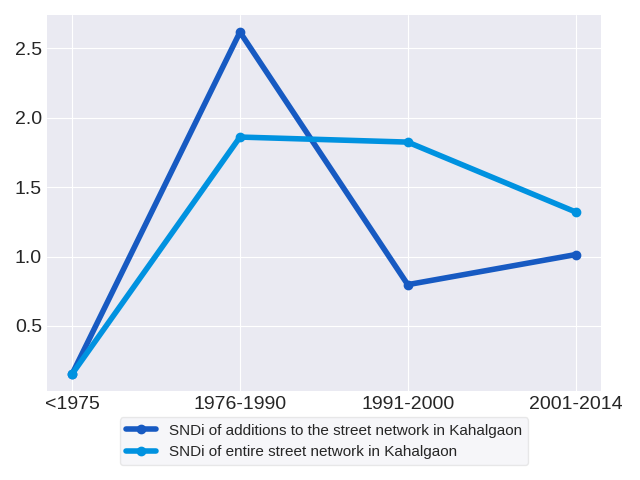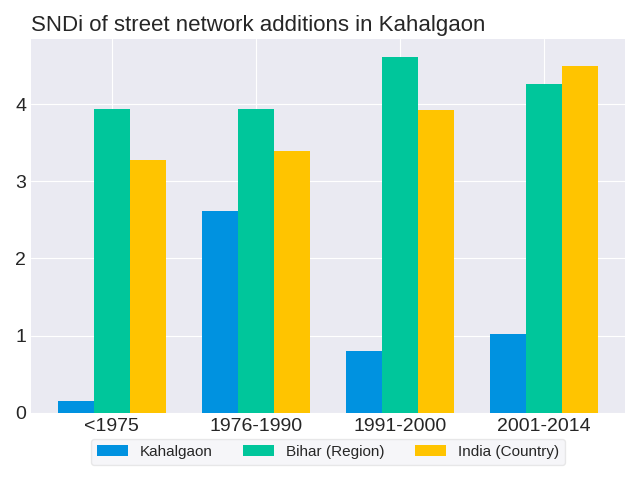Kahalgaon: city in Bihar, India


What exactly constitutes the spatial extent of the city? For these aggregations, we used the Global Human Settlement Layer Urban Center Database (GHS-UCDB) to define the boundaries of the city. These cities -- or urban centers -- cover areas that are densely populated and built-up, and so may extend beyond the spatial borders of these cities that we may be familiar with. The GHS area is shaded in blue.
View Kahalgaon, India on the sprawlmap


Most recent snapshot: Taking into account the entire (i.e. aggregate) street network in Kahalgaon as of 2014, the overall level of street-network sprawl is 1.32, which is relatively well-connected.
Trends in street network construction: The SNDis of street construction for the respective time periods are 0.15, 2.62, 0.8 and 1.01. Disconnectivity in street construction in Kahalgaon follows a zig-zag trend. In 1975, street construction was most disconnected, while construction was most connected in 1976-1990.
Quantity of street network construction: The street network in Kahalgaon spans a total of 31 kilometers. It is dominated by roads constructed in 2001-2014. These roads have an SNDi of 1.01, which is relatively well-connected.
Effect on the aggregate network: New construction in each period adds to the total stock of streets, but does not change streets that have already been built. Therefore, it has a limited effect on the street network as a whole. The SNDis of the aggregate street network in the respective time periods are 0.15, 1.86, 1.82 and 1.32. The aggregate street network in Kahalgaon increased in disconnectivity initially,but the trend has turned around after 1990.

Kahalgaon and Bihar do not follow the same trend in the disconnectivity of their street network constructions. The SNDi in Kahalgaon followed a zig-zag trend with an overall increase, while the SNDi of street constructions in Bihar followed a zig-zag trend with an overall increase.
How do development practices in Kahalgaon fare in comparison to others in Bihar? Most recently in 2001-2014, street construction in Kahalgaon was the 49th-most disconnected out of the 120 cities in Bihar. Its position in the ranks since 1975 has fallen; relative to other cities in Bihar, street construction in Kahalgaon has become more connected. Kahalgaon ranked 36th in 1975, 46th in 1976-1990, 34th in 1991-2000 and 49th in 2001-2014.
Kahalgaon and India do not follow the same trend in the disconnectivity of their street network constructions. The SNDi in Kahalgaon followed a zig-zag trend with an overall increase, while the SNDi of street constructions in India rose steadily.
How do development practices in Kahalgaon fare in comparison to others in India? Most recently in 2001-2014, street construction in Kahalgaon was the 1020th-most disconnected out of the 1716 cities in India. Its position in the ranks since 1975 has fallen; relative to other cities in India, street construction in Kahalgaon has become more connected. Kahalgaon ranked 773rd in 1975, 555th in 1976-1990, 888th in 1991-2000 and 1020th in 2001-2014.

Kahalgaon and Bihar do not follow the same trend in the disconnectivity of their aggregate street networks. The SNDi in Kahalgaon peaked in 1976-1990, while the SNDi of street constructions in Bihar rose steadily.
To date, Kahalgaon is the 77th-most disconnected out of the 120 cities in Bihar. Its position in the ranks since 1975 has fallen; relative to other cities in Bihar, the street network in Kahalgaon has become more connected. Kahalgaon ranked 36th in 1975, 56th in 1976-1990, 59th in 1991-2000 and 77th in 2001-2014.
Kahalgaon and India do not follow the same trend in the disconnectivity of their aggregate street networks. The SNDi in Kahalgaon peaked in 1976-1990, while the SNDi of street constructions in India rose steadily.
To date, Kahalgaon is the 1221st-most disconnected out of the 1716 cities in India. Its position in the ranks since 1975 has fallen; relative to other cities in India, the street network in Kahalgaon has become more connected. Kahalgaon ranked 773rd in 1975, 819th in 1976-1990, 945th in 1991-2000 and 1221st in 2001-2014.
As of 2015, Kahalgaon had a built-up area of 1.41 square kilometers, and a population of 121119 people.
These are some other cities with approximately the same population: